How to spot fraudulent emails like "Sigrid Trust Rim Foundation"
Phishing/ScamAlso Known As: Sigrid Trust Rim Foundation phishing email
Get free scan and check if your device is infected.
Remove it nowTo use full-featured product, you have to purchase a license for Combo Cleaner. Seven days free trial available. Combo Cleaner is owned and operated by RCS LT, the parent company of PCRisk.com.
What is "Sigrid Trust Rim Foundation" scam email?
We have reviewed the email and determined that it is a scam disguised as a notification regarding an award. This type of email is known as a phishing email, and the scammers behind it aim to steal sensitive information and (or) money from recipients. Therefore, this email should be ignored and deleted.
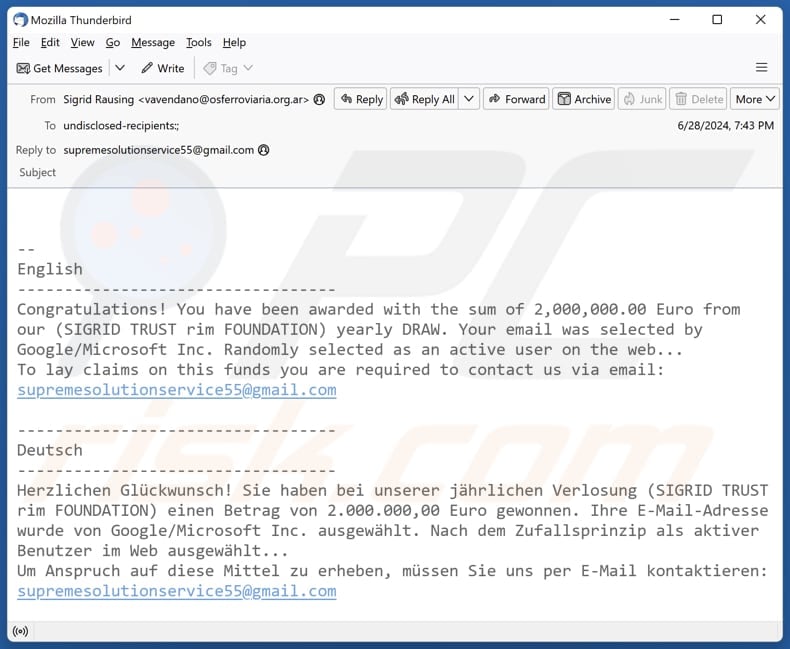
More about the "Sigrid Trust Rim Foundation" scam email
The scam email (written in English and German) claims that the recipient has won €2,000,000 from the "SIGRID TRUST rim FOUNDATION" yearly draw. It states that their email was randomly selected by Google/Microsoft Inc. as an active web user. In order to claim the prize, the recipient is instructed to contact the provided email address (supremesolutionservice55@gmail.com).
This is a phishing scam designed to extract personal information or money from unsuspecting individuals. Scammers may ask for credit card details, ID card information, social security number, login credentials, name, surname, telephone number, address, and (or) other information. This information may be used for financial fraud, identity theft, or other purposes.
Also, scammers might ask to make a payment under the guise of claiming a prize. They may state that the recipient has to pay some "administration" or other fee. Either way, such emails should be ignored. Victims who fall for such scams never receive any prizes or other rewards.
| Name | Sigrid Trust Rim Foundation Email Scam |
| Threat Type | Phishing, Scam, Social Engineering, Fraud |
| Fake Claim | The recipient has won €2,000,000 |
| Cyber Criminal's Email Address | helpservice322@gmail.com, armanibayer88@yhoo.com, evaf43682@gmail.com, sharongold615@gmail.com, armanibayer88@yhoo.com, sgrausing@gmail.com, supremesolutionservice55@gmail.com |
| Disguise | Letter from Sigrid Trust Rim Foundation |
| Symptoms | Unauthorized online purchases, changed online account passwords, identity theft, illegal access of the computer. |
| Distribution methods | Deceptive emails, rogue online pop-up ads, search engine poisoning techniques, misspelled domains. |
| Damage | Loss of sensitive private information, monetary loss, identity theft. |
| Malware Removal (Windows) |
To eliminate possible malware infections, scan your computer with legitimate antivirus software. Our security researchers recommend using Combo Cleaner. Download Combo CleanerTo use full-featured product, you have to purchase a license for Combo Cleaner. 7 days free trial available. Combo Cleaner is owned and operated by RCS LT, the parent company of PCRisk.com. |
Similar scam emails in general
In conclusion, scams that claim recipients have won large sums of money or valuable prizes are designed to deceive individuals into disclosing personal information or transferring money. Identifying and ignoring such emails is important to avoid identity theft, financial loss, or other issues.
Being careful and verifying the legitimacy of unexpected emails (or messages) can help protect against these common phishing tactics. Some examples of similar emails are "Department Of Treasury - Compensation Funds", "Fund Transaction", and "Trustworthy Foreign Partner". Emails of this kind can also be used to distribute malware.
How do spam campaigns infect computers?
Emails that cybercriminals use to distribute malware contain malicious links or attachments. The purpose of such emails is to trick recipients into downloading harmful software onto their devices. The included links can lead to websites that automatically download malware or convince users to download malicious files/programs.
Files that cybercriminals send via email can include malicious ZIP and RAR archives, PDF documents, ISO files, JavaScript files, MS Office documents, executables, etc. These files do not always inject malware upon opening. For instance, malicious MS Office documents can deploy malware when users enable macro commands. Malicious executable files can infect devices upon opening.
How to avoid installation of malware?
Always download software or files from reliable sources, such as official websites or app stores. Be cautious with unexpected emails from unknown senders, particularly those containing links or attachments. Avoid downloading pirated software, cracking tools, or unofficial key generators. Do not trust ads, buttons, and pop-ups on suspicious websites.
Do not permit dubious websites to send you notifications. Keep your operating system and installed software up to date, and scan your computer for threats regularly. Utilize a reputable security solution to protect your computer. If you have already opened malicious attachments, we recommend running a scan with Combo Cleaner Antivirus for Windows to automatically eliminate infiltrated malware.
Text presented in the "Sigrid Trust Rim Foundation" email letter:
English
----------------------------------
Congratulations! You have been awarded with the sum of 2,000,000.00 Euro from our (SIGRID TRUST rim FOUNDATION) yearly DRAW. Your email was selected by Google/Microsoft Inc. Randomly selected as an active user on the web...
To lay claims on this funds you are required to contact us via email: supremesolutionservice55@gmail.com----------------------------------
Deutsch
----------------------------------
Herzlichen Glückwunsch! Sie haben bei unserer jährlichen Verlosung (SIGRID TRUST rim FOUNDATION) einen Betrag von 2.000.000,00 Euro gewonnen. Ihre E-Mail-Adresse wurde von Google/Microsoft Inc. ausgewählt. Nach dem Zufallsprinzip als aktiver Benutzer im Web ausgewählt...
Um Anspruch auf diese Mittel zu erheben, müssen Sie uns per E-Mail kontaktieren: supremesolutionservice55@gmail.com
Other examples of emails from "Sigrid Trust Rim Foundation" spam campaign:
Sample 1:
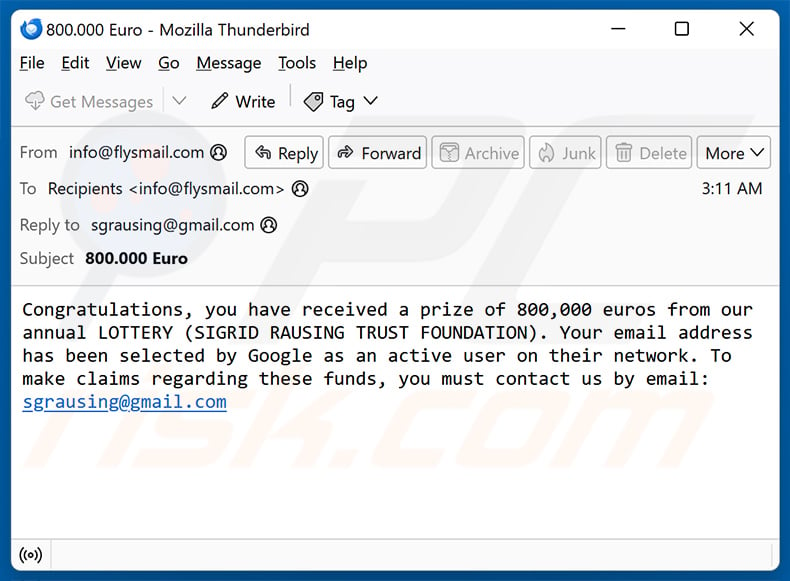
Text presented within:
Subject: 800.000 Euro
Congratulations, you have received a prize of 800,000 euros from our annual LOTTERY (SIGRID RAUSING TRUST FOUNDATION). Your email address has been selected by Google as an active user on their network. To make claims regarding these funds, you must contact us by email: sgrausing@gmail.com
Sample 2:
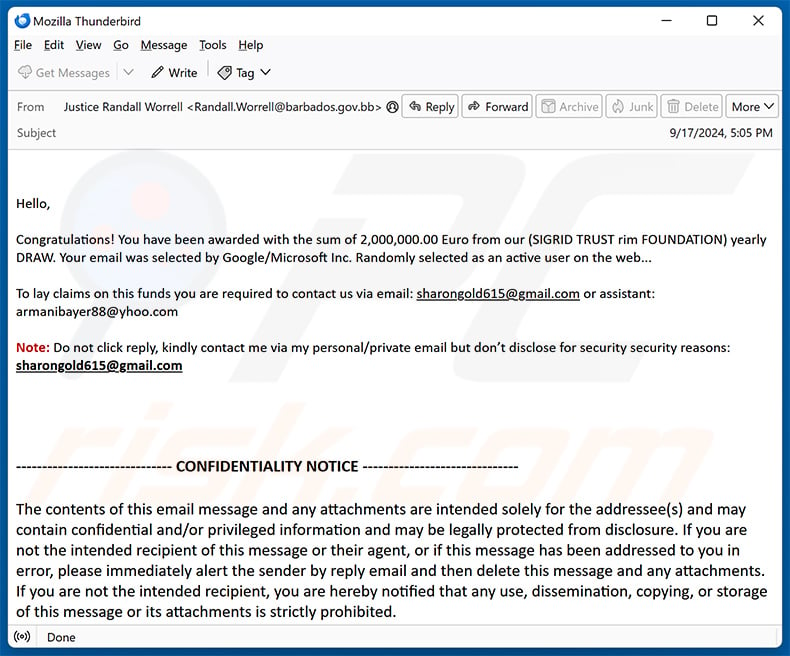
Text presented within:
Hello,
Congratulations! You have been awarded with the sum of 2,000,000.00 Euro from our (SIGRID TRUST rim FOUNDATION) yearly DRAW. Your email was selected by Google/Microsoft Inc. Randomly selected as an active user on the web...
To lay claims on this funds you are required to contact us via email: sharongold615@gmail.com or assistant: armanibayer88@yhoo.com
Note: Do not click reply, kindly contact me via my personal/private email but don’t disclose for security security reasons: sharongold615@gmail.com
Sample 3:
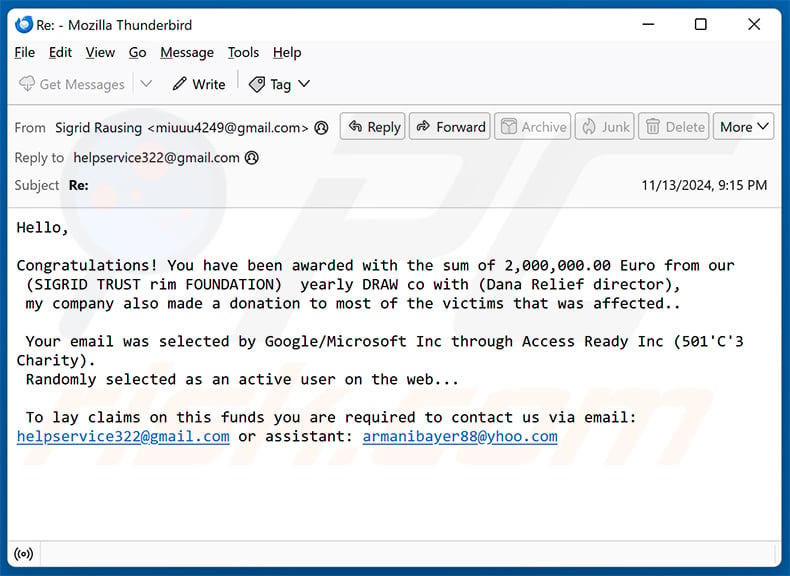
Text presented within:
Hello,
Congratulations! You have been awarded with the sum of 2,000,000.00 Euro from our (SIGRID TRUST rim FOUNDATION) yearly DRAW co with (Dana Relief director), my company also made a donation to most of the victims that was affected..
Your email was selected by Google/Microsoft Inc through Access Ready Inc (501'C'3 Charity).
Randomly selected as an active user on the web...To lay claims on this funds you are required to contact us via email: helpservice322@gmail.com or assistant: armanibayer88@yhoo.com
Sample 4:
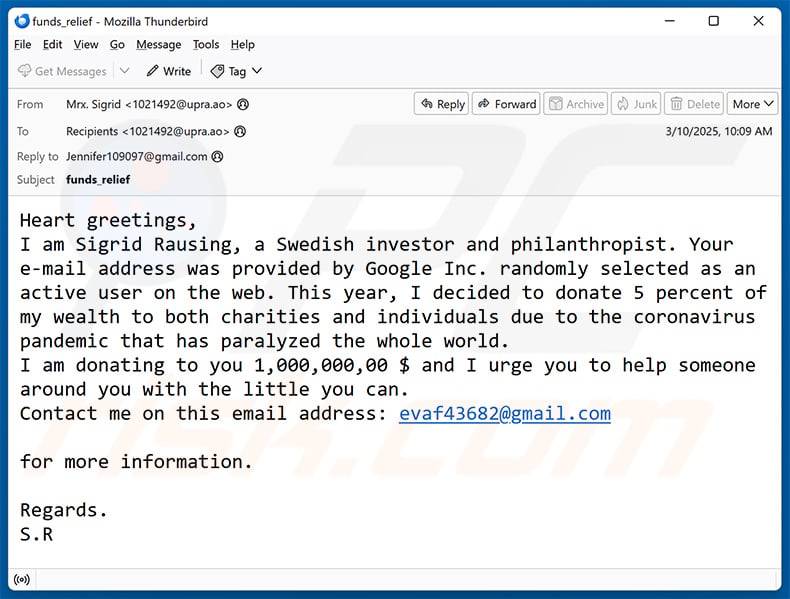
Text presented within:
Subject: funds_relief
Heart greetings,
I am Sigrid Rausing, a Swedish investor and philanthropist. Your e-mail address was provided by Google Inc. randomly selected as an active user on the web. This year, I decided to donate 5 percent of my wealth to both charities and individuals due to the coronavirus pandemic that has paralyzed the whole world.
I am donating to you 1,000,000,00 $ and I urge you to help someone around you with the little you can.
Contact me on this email address: evaf43682@gmail.comfor more information.
Regards.
S.R
Instant automatic malware removal:
Manual threat removal might be a lengthy and complicated process that requires advanced IT skills. Combo Cleaner is a professional automatic malware removal tool that is recommended to get rid of malware. Download it by clicking the button below:
DOWNLOAD Combo CleanerBy downloading any software listed on this website you agree to our Privacy Policy and Terms of Use. To use full-featured product, you have to purchase a license for Combo Cleaner. 7 days free trial available. Combo Cleaner is owned and operated by RCS LT, the parent company of PCRisk.com.
Quick menu:
- What is Sigrid Trust Rim Foundation phishing email?
- Types of malicious emails.
- How to spot a malicious email?
- What to do if you fell for an email scam?
Types of malicious emails:
![]() Phishing Emails
Phishing Emails
Most commonly, cybercriminals use deceptive emails to trick Internet users into giving away their sensitive private information, for example, login information for various online services, email accounts, or online banking information.
Such attacks are called phishing. In a phishing attack, cybercriminals usually send an email message with some popular service logo (for example, Microsoft, DHL, Amazon, Netflix), create urgency (wrong shipping address, expired password, etc.), and place a link which they hope their potential victims will click on.
After clicking the link presented in such email message, victims are redirected to a fake website that looks identical or extremely similar to the original one. Victims are then asked to enter their password, credit card details, or some other information that gets stolen by cybercriminals.
![]() Emails with Malicious Attachments
Emails with Malicious Attachments
Another popular attack vector is email spam with malicious attachments that infect users' computers with malware. Malicious attachments usually carry trojans that are capable of stealing passwords, banking information, and other sensitive information.
In such attacks, cybercriminals' main goal is to trick their potential victims into opening an infected email attachment. To achieve this goal, email messages usually talk about recently received invoices, faxes, or voice messages.
If a potential victim falls for the lure and opens the attachment, their computers get infected, and cybercriminals can collect a lot of sensitive information.
While it's a more complicated method to steal personal information (spam filters and antivirus programs usually detect such attempts), if successful, cybercriminals can get a much wider array of data and can collect information for a long period of time.
![]() Sextortion Emails
Sextortion Emails
This is a type of phishing. In this case, users receive an email claiming that a cybercriminal could access the webcam of the potential victim and has a video recording of one's masturbation.
To get rid of the video, victims are asked to pay a ransom (usually using Bitcoin or another cryptocurrency). Nevertheless, all of these claims are false - users who receive such emails should ignore and delete them.
How to spot a malicious email?
While cyber criminals try to make their lure emails look trustworthy, here are some things that you should look for when trying to spot a phishing email:
- Check the sender's ("from") email address: Hover your mouse over the "from" address and check if it's legitimate. For example, if you received an email from Microsoft, be sure to check if the email address is @microsoft.com and not something suspicious like @m1crosoft.com, @microsfot.com, @account-security-noreply.com, etc.
- Check for generic greetings: If the greeting in the email is "Dear user", "Dear @youremail.com", "Dear valued customer", this should raise suspiciousness. Most commonly, companies call you by your name. Lack of this information could signal a phishing attempt.
- Check the links in the email: Hover your mouse over the link presented in the email, if the link that appears seems suspicious, don't click it. For example, if you received an email from Microsoft and the link in the email shows that it will go to firebasestorage.googleapis.com/v0... you shouldn't trust it. It's best not to click any links in the emails but to visit the company website that sent you the email in the first place.
- Don't blindly trust email attachments: Most commonly, legitimate companies will ask you to log in to their website and to view any documents there; if you received an email with an attachment, it's a good idea to scan it with an antivirus application. Infected email attachments are a common attack vector used by cybercriminals.
To minimise the risk of opening phishing and malicious emails we recommend using Combo Cleaner Antivirus for Windows.
Example of a spam email:

What to do if you fell for an email scam?
- If you clicked on a link in a phishing email and entered your password - be sure to change your password as soon as possible. Usually, cybercriminals collect stolen credentials and then sell them to other groups that use them for malicious purposes. If you change your password in a timely manner, there's a chance that criminals won't have enough time to do any damage.
- If you entered your credit card information - contact your bank as soon as possible and explain the situation. There's a good chance that you will need to cancel your compromised credit card and get a new one.
- If you see any signs of identity theft - you should immediately contact the Federal Trade Commission. This institution will collect information about your situation and create a personal recovery plan.
- If you opened a malicious attachment - your computer is probably infected, you should scan it with a reputable antivirus application. For this purpose, we recommend using Combo Cleaner Antivirus for Windows.
- Help other Internet users - report phishing emails to Anti-Phishing Working Group, FBI’s Internet Crime Complaint Center, National Fraud Information Center and U.S. Department of Justice.
Frequently Asked Questions (FAQ)
Why did I receive this email?
Scammers send identical letters to thousands of recipients, hoping that someone will fall for the fraudulent scheme. These spam emails are never (or almost never) personalized.
I have provided my personal information when tricked by this email, what should I do?
If you have provided login credentials (e.g., your username and password), change all passwords that may be compromised. If you have shared other personal information, such as credit card details or ID card information, contact the relevant authorities (e.g., police or bank).
I have downloaded and opened a file attached to an email, is my computer infected?
It depends on the file type. For instance, malicious MS Office documents cannot inject malware unless macros commands are enabled. However, malicious executables can infect computers upon opening.
I have sent cryptocurrency to the address presented in such email, can I get my money back?
It is not possible to reverse cryptocurrency transcations. Thus, you cannot recover cryptocurrency sent to scammers.
I have read the email but did not open the attachment, is my computer infected?
No, opening an email is harmless. Cybercriminals behind fraudulent emails do not succeed unless recipients open malicious links or files.
Will Combo Cleaner remove malware infections that were present in email attachment?
Combo Cleaner can effectively detect and remove nearly all known malware. Sophisticated malware often conceals itself deeply within the system. For this reason, it is important to run a full system scan to detect and eliminate malware of this kind.
Share:

Tomas Meskauskas
Expert security researcher, professional malware analyst
I am passionate about computer security and technology. I have an experience of over 10 years working in various companies related to computer technical issue solving and Internet security. I have been working as an author and editor for pcrisk.com since 2010. Follow me on Twitter and LinkedIn to stay informed about the latest online security threats.
PCrisk security portal is brought by a company RCS LT.
Joined forces of security researchers help educate computer users about the latest online security threats. More information about the company RCS LT.
Our malware removal guides are free. However, if you want to support us you can send us a donation.
DonatePCrisk security portal is brought by a company RCS LT.
Joined forces of security researchers help educate computer users about the latest online security threats. More information about the company RCS LT.
Our malware removal guides are free. However, if you want to support us you can send us a donation.
Donate
▼ Show Discussion